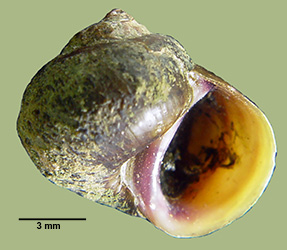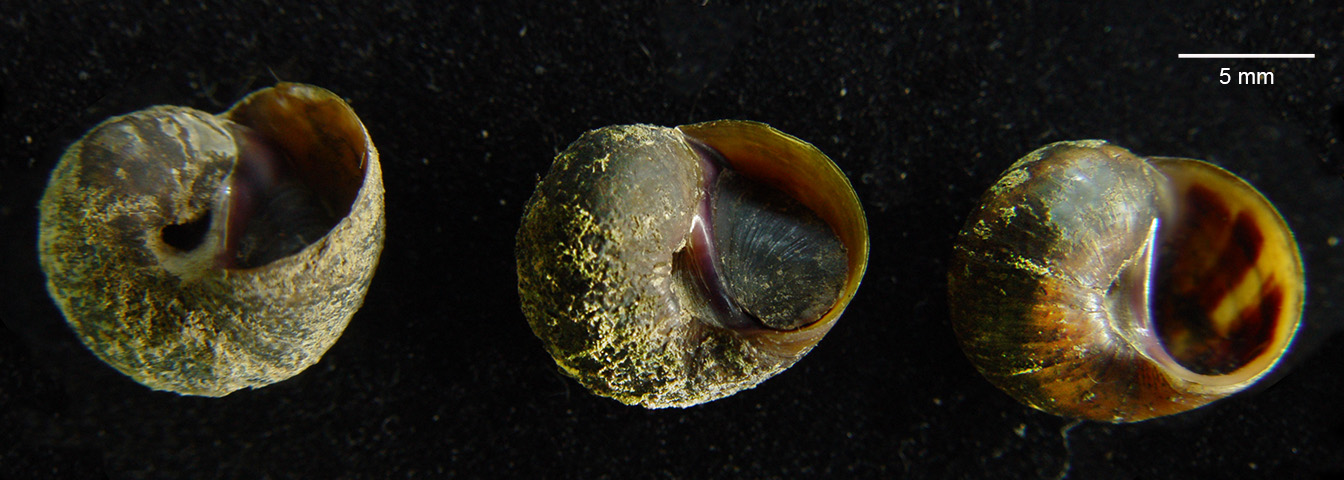> Habitat & Distribution
The range of L. umbilicata was given by Goodrich (1940) as "Stone's River, Red River, and Ringgold Creek (a Red River tributary) of the Cumberland River, all in Tennessee; Elk River, Franklin County, Tennessee." Our modern surveys have confirmed several populations of otherwise typical Leptoxis praerosa bearing predominantly-umbilicate shells in the Stones and Red subdrainages. The umbilicate shell character also seems to be demonstrated sporadically in the Elk River, sprinkled in populations of typical L. praerosa. Evans and Whelan (2014) added a possible record from the Rockcastle River in Kentucky, although our observations do not tend to confirm.
The habitat of L. praerosa umbilicata is not different from that of the typical subspecies, reaching maximum population densities in medium-sized rivers, on rocks in riffles with good flow. Populations are not commonly encountered in small creeks or streams, nor in larger rivers where substrates become too soft or silty. The FWGNA incidence rank combining both the typical and umbilicate forms together is I-5.
> Ecology & Life History
Grazing by populations of pleurocerids can have a significant effect on energy flow in small streams (Dillon 2000: 86 - 91, see also Dillon & Davis 1991).
Like other pleurocerids, L. praerosa is dioecious, eggs being deposited on hard substrates from spring to mid-summer. Whelan and colleagues (2015) described eggs as being laid "singly in an apparently random manner" under their culture conditions. Although we are unaware of any study specifically directed toward the life history of L. praerosa, it seems reasonable to expect that two years will be required for maturity, and that several years of iteroparous reproduction can be expected thereafter, as is the case for pleurocerids generally (Dazo 1965). This is life cycle Hi of Dillon (2000: 156 - 162).
> Taxonomy & Systematics
Several populations of Leptoxis praerosa from central and southern Tennessee served as controls for the allozyme surveys of Dillon & Ahlstedt (1997) and Dillon & Lydeard (1998), and for the mtDNA sequence study of Whelan & Strong (2016). See my essay of 3Apr16 from the link below for more. "Anculosa" is a commonly-encountered synonym for the genus.
The 2013 Ph.D. dissertation of N. V. Whelan comprised six chapters, the fifth of which reported an extensive molecular phylogeny of the North American Pleuroceridae based on four genes (two mitochondrial and two nuclear) sequenced from 207 individuals sampled from 62 populations of 32 nominal species and subspecies, including an openly-umbilicate Leptoxis population from the East Fork of the Stones River. Whelan's results did not return any evidence of genetic divergence between this population and nearby populations of typical Leptoxis praerosa. This result was confirmed by the AHE phylogenomic study of Whelan et al. (2002).
Our observations on Leptoxis praerosa populations sampled throughout the greater Ohio/Tennessee/Cumberland drainage system suggest that the development of an open shell umbilicus is variable and perhaps ecophenotypic in its origin. The figure below depicts intergradation between the umbilicate and typical shell forms in Little West Fork, a tributary of the Red River north of Clarksville, TN. Observations such as this, together with the genetic data of Whelan (2013), suggest that L. umbilicata (Wetherby 1876) be lowered to subspecific status.
> Maps and Supplementary Resources
- Leptoxis distribution in the drainage of The Ohio (2019)
- Leptoxis distribution in the Tennessee/Cumberland (2022)
> Essays
- Although focused on the pleurocerid fauna of the Mobile Basin, the genetic survey of Whelan & Strong (2016) also included mtDNA sequence data from a North Alabama population of L. praerosa as an outgroup control. Their results were reviewed in my essay of 3May16, Mitochondrial Superheterogeneity and Speciation.
- I reviewed my 50 years of field and laboratory experience with pleurocerid populations of the genus Leptoxis in a blog post of 6Apr23, Growing up with Periwinkles, devoting several paragraphs to L. praerosa in particular.
- See my essay of 9May23, Testing the Periwinkle Hypothesis, for an appreciation of N.V. Whelan's impressive (2013) DNA sequence data set drawn from 31 populations of Leptoxis sampled across eastern North America. Among the many important results of Nathan's phylogenetic analysis was confirmation that L. umbilicata is not specifically distinct from L. praerosa.
- The evolutionary relationships among all six of the biological species of the genus Leptoxis were wonderfully revealed by the AHE phylogenomic study of Whelan et al. (2022). For a review, see my post of 13Nov25, Anchored hybrid enrichment, Leptoxis lessons, and the advice of Queen Elsa.
> References
Dazo, B. C. 1965. The morphology and natural history of Pleurocera acuta and Goniobasis livescens (Gastropoda: Cerithiacea: Pleuroceridae). Malacologia 3: 1 - 80.
Dillon, R. T. Jr. (1989) Karyotypic evolution in pleurocerid snails: I. Genomic DNA estimated by flow cytometry. Malacologia, 31: 197-203.
Dillon, R. T. Jr. (1992) Status survey of the knotty elimia, Goniobasis interrupta (Hald). Report to the North Carolina Wildlife Resources Commission, Contract 92-Snai-01. 19 pp.
Dillon, R. T. Jr. (2000) The Ecology of Freshwater Molluscs. Cambridge, Cambridge University Press. 509 pp.
Dillon, R. T. Jr. & S. A. Ahlstedt (1997) Verification of the specific status of the endangered Anthony's River Snail, Athearnia anthonyi, using allozyme electrophoresis. Nautilus 110: 97-101.
Dillon, R. T. Jr., & K. B. Davis (1991) The diatoms ingested by freshwater snails: temporal, spatial, and interspecific variation. Hydrobiologia 210: 233-242.
Dillon, R. T. Jr., and C. Lydeard (1998) Divergence among Mobile Basin populations of the pleurocrid snail genus, Leptoxis, estimated by allozyme electrophoresis. Malacologia 39: 113-121.
Evans, R. & N. Whelan (2014) Recent observation of Leptoxis from the Rockcastle River, Kentucky. Ellipsaria 16(4): 27 - 28.
Goodrich, C. (1940) The Pleuroceridae of the Ohio River drainage system. Occas. Pprs. Mus. Zool. Univ. Mich., 417: 1-21.
Jokinen, E.H. 1992. The Freshwater Snails (Mollusca: Gastropoda) of New York State. NY State Mus Bull 482, Albany, New York.
Smith, D.G. 1980. Goniobasis virginica Gastropoda Pleuroceridae in the Connecticut River USA. Nautilus 94:50-54.
Stewart, T. W., & R. T. Dillon, Jr. (2004) Species composition and geographic distribution of Virginia's freshwater gastropod fauna: A review using historical records. Am. Malac. Bull. 19: 79-91.
Whelan, N.V. (2013) Conservation, life history and systematics of Leptoxis Rafinesque 1819 (Gastropoda: Cerithioidea: Pleuroceridae). Ph.D. dissertation, University of Alabama, Tuscaloosa. 157 pp.
Whelan, N.V., P.D. Johnson, J.T. Garner, N.L. Garrison, and E.E. Strong (2022) Prodigious paraphyly in Pleuroceridae (Gastropoda: Cerithoidea). Bulletin of the Society of Systematic Biologists 1(2). https://doi.org/10.18061/bssb.v1i2.8419
Whelan, N. V., P.D. Johnson & P. M. Harris (2015) Life-history traits and shell morphology in the genus Leptoxis Rafinesque, 1819. J. Moll. Stud. 81: 85-95.
Whelan, N.V. & E. E. Strong (2016) Morphology, molecules and taxonomy: extreme incongruence in pleurocerids (Gastropoda, Cerithiodea, Pleuroceridae). Zoologica Scripta 45: 62 87.









